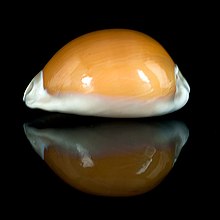| Callistocypraea aurantium | |
|---|---|

| |
| A lateral view of a shell of Callistocypraea aurantium, anterior end towards the left | |

| |
| Dorsal view of a shell of Callistocypraea aurantium, anterior end to the right | |
| Scientific classification | |
| Domain: | Eukaryota |
| Kingdom: | Animalia |
| Phylum: | Mollusca |
| Class: | Gastropoda |
| Subclass: | Caenogastropoda |
| Order: | Littorinimorpha |
| Family: | Cypraeidae |
| Genus: | Callistocypraea |
| Species: | C. aurantium
|
| Binomial name | |
| Callistocypraea aurantium (Gmelin, 1791)
| |
| Synonyms[1] | |
Callistocypraea aurantium, (formerly classified inside genus lyncina) common name the golden cowrie, is a species of sea snail, a cowry, a marine gastropod mollusk in the family Cypraeidae, the cowries.[2]